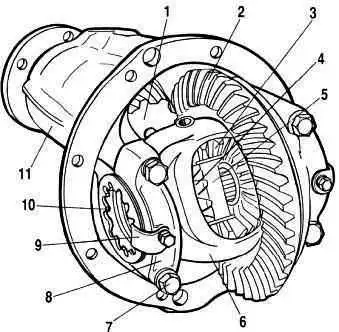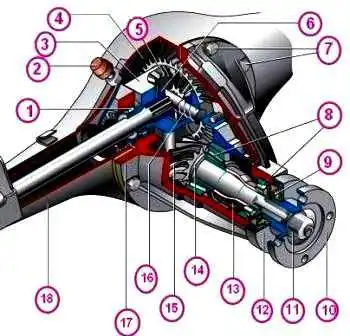The main gear pinion is made integral with the shaft (tailpiece) and is installed in the gearbox neck on two tapered bearings.
The outer bearing rings are pressed into the neck seats, and the inner ones are put on the tailpiece
A spacer sleeve is installed between the inner rings; when tightening the tailpiece nut, the sleeve is deformed, providing a constant preload of the bearings.
The preload of the bearings is controlled by the torque of the drive gear (other parts are not installed).
For new bearings, the torque should be within 157-197 Ncm, for bearings after a run of 30 km or more - 39-59 Ncm.
In this case, the tailpiece nut is tightened with a torque of 118-255 Nm, periodically checking the rotation of the drive gear.

If the specified turning torque has already been reached, and the tightening force of the nut is less than 118 Nm, it is necessary to replace the spacer sleeve with a new one, since the old one is deformed too much.
The sleeve must also be replaced if the turning torque is higher than the permissible value (due to carelessness during tightening).
If the main pair or the bearings of the drive gear are replaced, it is necessary to re-select the thickness of the adjusting ring.
It is installed on the shaft between the drive gear and the inner ring of the large bearing.
The driven gear of the main transmission is attached to the flange of the differential box with special bolts without washers. These bolts cannot be replaced with any other ones.
The differential box rotates in two tapered bearings.
Their preload, as well as the gap between the teeth of the main gear gears, is adjusted by nuts screwed into the detachable bearing beds.
The half-axle gears are installed in cylindrical sockets of the differential box and rest on it through support washers.
These washers are selected by thickness so that the gap between the teeth of the satellites and the half-axle gears is within 0.0-0.1 mm.
The satellites are mounted on the axle with constant engagement with the half-axle gears.
The axle has spiral grooves for supplying lubricant to the rubbing surfaces.
One end of the half-axle rests on a single-row ball bearing (with protective washers and a lifetime supply of grease) installed in the rear axle beam socket, and the other (splined) end enters the axle gear.
The inner ring of the bearing is fixed to the axle shaft with a locking ring installed with interference (shrink fit).
The outer ring of the bearing is fixed with a plate, which, together with the oil deflector and brake shield, is fastened with four bolts and nuts to the rear axle beam.
Determining gearbox faults by noise
Troubleshoot in the following order.

Test 1
To clearly identify the nature of the noise, drive the car on the highway at a speed of approximately 20 km / h.
Then gradually increase the speed to 90 km / h, listening simultaneously for different types of noise and noting the speed at which they appear and disappear.
Release the throttle pedal and without braking, reduce the speed with the engine.
While decelerating, pay attention to the change in the noise, as well as the moment when the noise increases.
Typically, the noise appears and disappears at the same speeds, both during acceleration and deceleration.
Test 2
Accelerate the car to approximately 100 km / h, put the gearshift lever in gears to neutral and let the car roll freely to a stop; monitor the nature of the noise at various deceleration speeds.
Noise that depends on the manipulation of the accelerator pedal comes from the final drive.
Bearings can also make noise when coasting: the bearings of the pinion gear make a hissing and roaring noise, and the bearings of the differential and axle shafts produce a low-frequency roar.
Test 3
With the car stationary and braked, turn on the engine and, gradually increasing its speed, compare the noise that arises with that noted in the previous tests.
Noises that turn out to be similar to the noises of test 1 indicate that they are not gearbox noise and are caused by other components.





